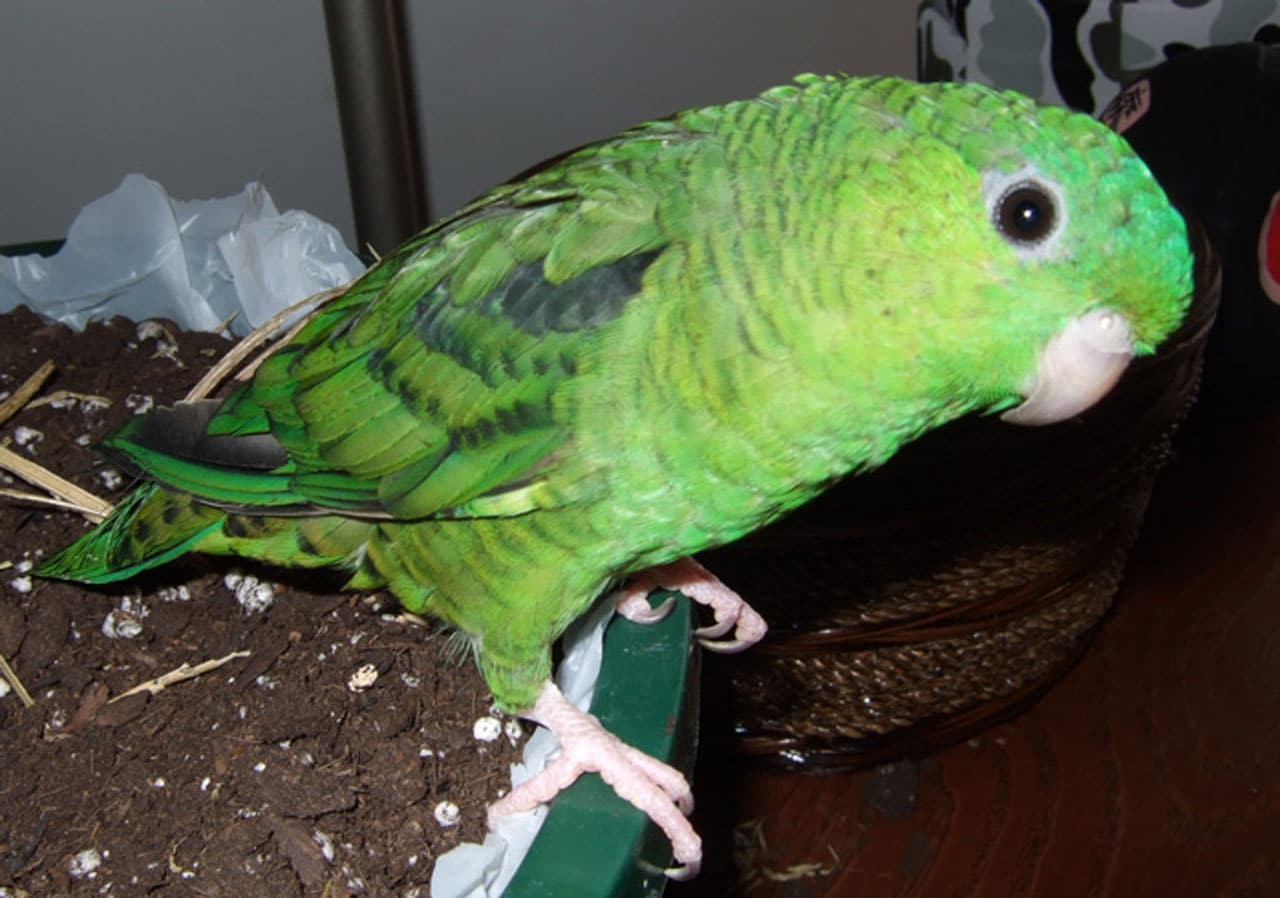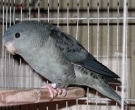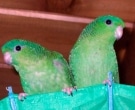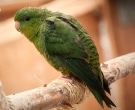Content |
|---|
Description:
They measure 17 cm. long and weigh between 47 and 55 g.
The Barred Parakeet (Bolborhynchus lineola) has a size similar to the of a Sparrow. The tail and wings they are pointed. Slightly different sexes: in males, the eyes they are brown, the eye ring grey, the bill and legs flesh-colored. The head and underparts they are bright green, with a tenuous beaming on the sides and the tail coverts. The wings they have very marked black bars at the shoulder and patch black(not always visible), the upperparts they are green with a beaming widely dispersed black in the nape and back.
The females and juveniles they present a beaming more pardo. A wide black border and dark green bottom; the irises Dark coffee and legs pink (Howell and Webb, 1995).
- Sound of the Barred Parakeet.
Subspecies description:
-
(Cassin, 1853) – The nominal
Bolborhynchus lineola lineola
-
(Souance, 1856) – Dark green, Crown and bright green front and the rough black is more intense.
Bolborhynchus lineola tigrinus
Habitat:
Rare and unpredictable. It lives in humid forests, subandinos and Andean cloud forests, open areas, from 900 at 2900m. They are nomads, with numerous flocks (150 or more individuals) following the fruition of the “chusque” (This chusquea). In small groups or in pairs during the dry season in Central America.
Reproduced in elevations of 1500 meters or more and, like most parrots, they prefer to raise their chicks in a hollow tree or limb trunk. In the winter after the breeding season, the Barred Parakeet often descends to lowland forests. This season, Many feed on partially cleared areas, areas cultivated and in them sheets.
Registered at altitudes from 900 to 2.400 m. in Mexico; by under 1.500 m. in Honduras, Although below 600 After the playback meters; above 1.500 m especially in the West of Panama, although there are records there and in Costa Rica below the 600 m; between 900 and 1,500 m. in Venezuela, between 1,600 and 2,600 m. in Colombia, and until 2.900 m. in the South of Ecuador.
Little known about the habits of these small wild parrots. Since they are small, they like to live high in the treetops, and they are very well camouflaged in their environment, still very hard to see in nature. It also, they are not as noisy as other parrots, which makes them difficult to detect. Most frequently observed during the flight, because they often emit a chirp while flying, What can attract the attention of an observer of birds.
Reproduction:
It nests colonies, in tree hollows, Although you can to occur in crevices in Rocky escarpments, probably during the dry season in Costa Rica; during the month of December in Panama; July-August in Colombia.
Food:
Reported foods that make up their diet include Myrtis, Heliocarpus and Miconia, catkins of Cecropia and bamboo seeds; they occasionally forage in cultivated areas, where has observed them is consuming corn.
Distribution:
Distributed in South of Mexico to western Panama and separated by the Andes, from Venezuela until Peru.
In Mexico they can be observed on the Atlantic slope, in the Highlands of Veracruz, Oaxaca, Chiapas and possibly (There is only a record) in Warrior, also seen in the South of Guatemala (a record from time to time) and in the Highlands of Honduras, with a single bird observed in Nicaragua, specifically in Saint Mary of Ostuma; also registered in those areas mountain of Costa Rica (not seen in areas of the Northwest, for example in the Cordillera de Guanacaste) and in the West of Panama (apparently absent from Central and Eastern).
Distributed through them Andes, to the Northwest of Venezuela in the Federal District, Táchira and Merida; scattered locations of Colombia, in subtropical areas of the Western Andes, Central and Eastern and in the massif of Santa Marta; Ecuadorian Andes, with records recent in the South; Peruvian Andes, in Huanuco, Ayacucho and Cuzco, with birds, possibly of this species, observed in the North.
Scattered records, e irregular, as well as a strong nomadic tendency (movements perhaps related to bamboo planting) they indicate that their appearances may be continuous.
Apparently, is one local and rare species over much of its range, Although according to reports, is quite common in Honduras and even locally abundant in the Talamanca mountain range in Costa Rica.
Deforestation in parts of its range, Although these birds travel on cleared land and distributed (at least from time to time) in protected areas, which suggests a low risk population at present.
There is a captive specimens outside their countries of origin.
Subspecies distribution:
-
(Cassin, 1853) – The nominal
Bolborhynchus lineola lineola
-
(Souance, 1856) – Mountains from northwestern Venezuela and Colombia to southern Peru
Bolborhynchus lineola tigrinus
Conservation:
State of conservation ⓘ |
||
|---|---|---|
 Minor Concern ⓘ
(UICN)ⓘ
Minor Concern ⓘ
(UICN)ⓘ
| ||
• Red List category of the UICN current: Least concern.
• Population trend: Stable.
Partners in Flight estimated the total population of Barred Parakeet in a number ranging from 50,000-499,999 individuals (A. Panjabi in litt., 2008).
The population This species is suspected of being stable in the absence of evidence of any reduction or substantial threats.
"Barred Parakeet" in captivity:
It is of a species that is has adapted well to the life in captivity, tough enough, its reproduction is expanding.
They are perfect apartment birds due to its arrangement and you need only basic things of life. Son kind and happy of being with the people, but they can be kept entertained with toys and swings when there is nobody around.
Is an Ave. moderately long-lived and if is of good health, Food and hygiene can live during 12 or 14 years.
Limited ability for speech.
They have developed many and striking mutations of color in poultry, including blue, olive, cobalt, Slate (or mauve), turquoise, lutino (bright yellow with red eyes), cremino, cinnamon, Silver, purple …
Alternative names:
– Barred Parakeet, Catherine Parakeet, Lineolated Parakeet (English).
– Toui catherine, Perruche catherine, Perruche rayée (French).
– Katharinasittich, Katharina Sittich (German).
– Periquito-catarina (Portuguese).
– Catita Barrada, Catita Manchada, Chocoyo Listado, Perico Barrado, Perico Listado, Perico rayado, Periquito Barrado, Periquito Listado, Periquito saraviado (español).
– Periquito Barrado (Colombia).
– Perico Listado, Periquito listado (Costa Rica).
– Perico rayado (Honduras).
– Perico rayado (Mexico).
– Chocoyo Listado (Nicaragua).
– Perico Barrado (Peru).
– Perico Barreteado (Venezuela).
scientific classification:
– Order: Psittaciformes
– Family: Psittacidae
– Genus: Bolborhynchus
– Scientific name: Bolborhynchus lineola
– Citation: (Cassin, 1853)
– Protonimo: Psittacula lineola
Images “Barred Parakeet”:
Videos "Barred Parakeet"
Sources:
– Avibase
– Parrots of the World – Forshaw Joseph M
– Parrots A Guide to the Parrots of the World – Tony Juniper & Mike Parr
– Birdlife
– Photos:
(1) – A Barred Parakeet (also known as Lineolated Parakeet) in captivity By Timo Helgert (originally posted to Flickr as greenguy.) [CC BY 2.0], via Wikimedia Commons
(2) – Two pet Barred Parakeets (also known as Lineolated Parakeet) perching on a parasol By Lisa Lenscap (originally posted to Flickr as sistas) [CC BY-SA 2.0], via Wikimedia Commons
(3) – Barred Parakeet (Bolborhynchus lineola) also known as Lineolated Parakeet or Catherine Parakeet By Lisa Lenscap [CC BY-SA 2.0], via Wikimedia Commons
(4) – Perruche Catherine de couleur mauve By Weena (Own work) [GFDL, CC-BY-SA-3.0 or CC BY-SA 2.5-2.0-1.0], via Wikimedia Commons
– Sounds:






